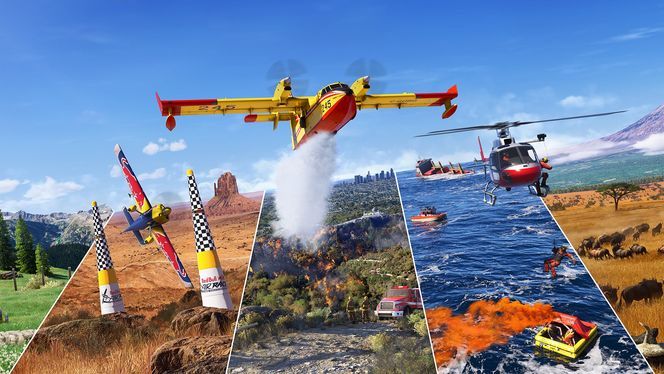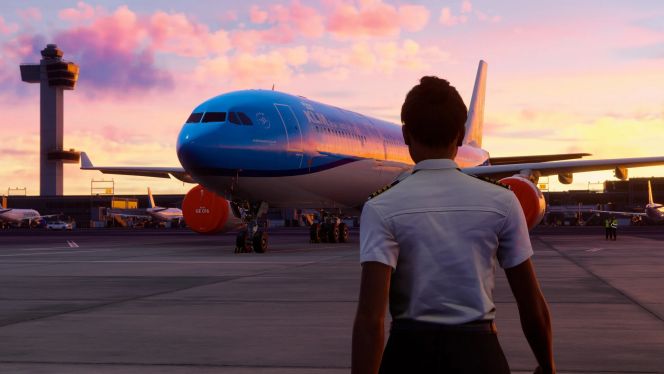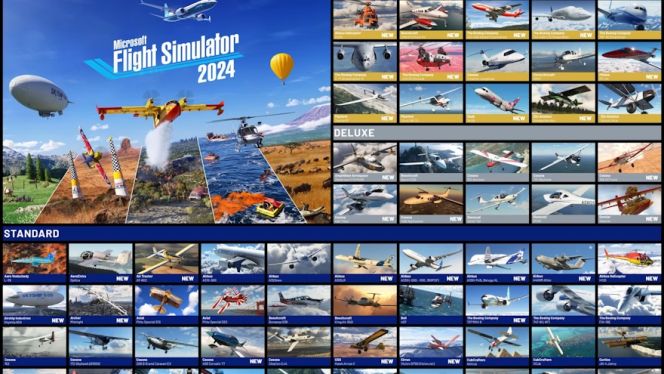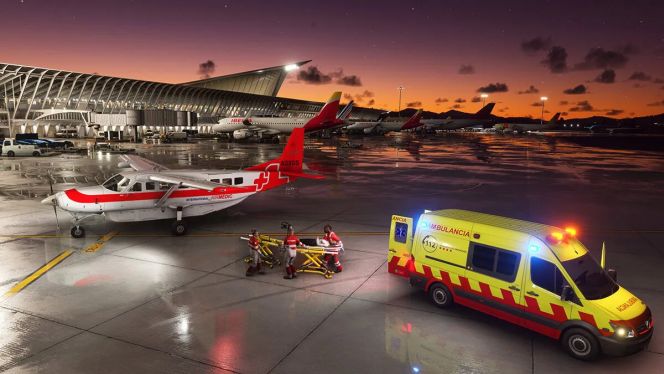REVIEW – Microsoft Flight Simulator 2024 takes off with sky-high ambitions, promising not only the thrill of piloting aircraft but also a groundbreaking level of realism. As the latest milestone in Microsoft’s iconic simulation series, the question is: does it live up to expectations? It’s worth noting that our review excludes technical issues from the game’s somewhat turbulent launch. We waited for critical bugs to be addressed before offering our verdict.
A few years ago, Microsoft amazed everyone by rebooting the legendary Flight Simulator series with an almost perfect rendition. Four years later, the same team returns for another ambitious flight. Microsoft Flight Simulator 2024 is finally here, bringing with it impressive improvements and fresh innovations. The real question: can this new installment soar to greater heights, or is turbulence already shaking the cabin?
Despite its rocky launch, this latest edition of Flight Simulator has finally landed. While far from flawless, the 2024 version represents a significant leap forward for the franchise. As usual, Microsoft and Asobo Studio have listened to fan feedback, creating something truly special while remaining faithful to the series’ essence.
The developers set the bar high with Flight Simulator 2020, particularly with its stunning visuals that left players in awe. Yet, despite its success, some gamers felt left out. Why? Because no matter how precise and detail-rich the game was, it remained fundamentally a hardcore simulator. For those uninterested in long hours of realistic flying or meticulously studying instruments, the experience could quickly become tedious or even overwhelming.
But by 2024, the winds have shifted. This new installment retains everything that made Flight Simulator 2020 exceptional: breathtaking visuals, intricate simulation, and incredible realism. However, it also adds a dimension players have long been waiting for: gameplay. With diverse missions, tangible objectives, and even cinematic scenarios, the experience is now more dynamic than ever. And for purists who crave an unadulterated simulation? Fear not: this new direction doesn’t betray the franchise’s legacy. On the contrary, it enriches and expands upon it.
Flight Simulator 2024 takes on a dual challenge: to satisfy hardcore simulation fans while also appealing to gamers seeking a more playful experience. Can it succeed? It’s time to find out.
A Career Mode That Takes You Around the Globe
The standout addition in this new installment is the career mode, packed with missions and clear objectives that allow players to pilot various vehicles across stunning global locations. Let’s be clear: this career mode isn’t just a welcome addition—it’s a vital step in keeping the Flight Simulator experience fresh and exciting.
As a longtime fan of the series, I was never bothered by its purely simulation-based approach. When Microsoft first teased the details of the career mode, I’ll admit I was skeptical. Like many others, I worried that the game’s core strengths—its unparalleled realism and immersive experience—might be diluted in an effort to attract a broader audience.
Yet, if this direction truly aims to bring in new players curious about the world of aviation without diving headfirst into the complexities of a pure simulation, the balance they’ve struck is astonishing. The career mode isn’t just a well-timed addition; it breathes fresh life into the game while seamlessly integrating with its DNA.
The experience begins with a well-designed tutorial, guiding players step-by-step through the different stages of a pilot’s career. The progression system is logical and motivating: each license must be earned by spending virtual money gained from completing missions. These challenges are varied and engaging, giving every flight a purpose far beyond simply admiring the view. This progression system adds an extra layer to the game, transforming each flight into an opportunity to hone your skills and unlock new horizons in the Flight Simulator 2024 universe.
What about the purists? They needn’t worry. The free-flight mode, a cornerstone of previous versions, remains untouched, ensuring that those who prefer an unstructured experience can still explore the world at their own pace.
In truth, this career mode enriches the experience without ever distorting it. Offering structured progression and thrilling aviation-focused challenges, it serves as a bridge between simulation and gameplay, uniting newcomers and seasoned fans under one sky.
The career mode missions significantly enhance the experience with diverse and often spectacular activities that fit perfectly with the game’s realism. Here are a few examples of what you can expect:
- Aerial firefighting: Take control of a Canadair aircraft to extinguish forest fires under extreme conditions.
- Search and rescue missions: Participate in precision rescue operations to aid those in distress.
- Cargo transport via helicopter: Deliver goods to hard-to-reach locations, demanding accuracy and skill.
- Air ambulance services: Save lives by swiftly transporting patients in critical environments.
- Agricultural spraying: Fly over fields to complete agricultural missions with precise timing.
- Mountain rescue operations: Use your helicopter to save hikers or climbers stranded in dangerous heights.
- Parachute drops: Transport parachutists and ensure perfectly timed jumps.
- Heavy-lift transport: Support construction projects by carrying massive loads with your helicopter.
- Oversized cargo delivery: Fly iconic aircraft like the Airbus Beluga to transport enormous goods.
- Arctic freight transport: Brave the frozen Arctic with an Airbus A400M.
- VIP transport: Provide luxury services to celebrities and business executives.
- Air races: Test your piloting skills in high-speed, adrenaline-pumping competitions.
- Glider flying: Harness air currents for a uniquely tranquil flying experience.
- Weather reconnaissance: Collect critical data amidst storms or high-altitude conditions.
- Experimental aircraft testing: Push the boundaries of aviation by testing cutting-edge prototypes.
- Low-level training flights: Master the art of flying close to the ground with the A-10 Warthog.
Each mission brings either adrenaline or a unique challenge, turning Flight Simulator 2024 into a true playground for aviation enthusiasts while staying true to its simulation roots. While missions start off simple and leave out some technical elements, they become genuine trials as you progress.
And that’s not all! Another mode lets you photograph some of the planet’s most iconic landmarks—whether historical buildings or stunning natural beauty. This playful element elevates the title to new heights. If you’re after quick challenges, a fast-paced mode is available. Plus, an online version allows you to compete against the best pilots out there.
FPS Mode: A Fun Addition, but Rough Around the Edges
One of the most intriguing new features is the first-person mode (FPS), which lets players explore Flight Simulator’s expansive world on foot. On paper, this sounds fantastic, but in practice, the execution is lacking. The environments are often inconsistent, and if you were hoping to stroll casually through your neighborhood, you’d better adjust your expectations—this feature still has a long way to go.
Yes, there’s an FPS mode, and it does add a little something to the overall experience. However, it’s far from as impressive as it initially seems. Animations are clunky, movement feels awkward, and the exploration area is strictly limited—you can’t stray far from your aircraft. Airport stairs are unusable, most decorative elements are intangible, and the flaws quickly become apparent: blurry textures, low-detail 3D objects, and an overall lack of polish.
That said, the mode has its strengths. During specific missions where it plays a prominent role, you can explore breathtaking locations and capture memorable photos. In such contexts, it adds real value. But in free mode, it’s too unpolished to be truly satisfying.
The FPS mode deserves credit for existing at all, opening up new possibilities for the franchise’s future. However, in its current state, it feels very much like a work-in-progress—promising but clearly experimental.
A Sky Full of Airplanes Awaits You!
Let’s not forget that at its core, Microsoft Flight Simulator is a game about planes—or a simulator, depending on your perspective—and this is where the 2024 edition truly shines. The variety of aircraft available is astonishing, and this is one area where the game definitely deserves a closer look. The game comes in several editions, each offering progressively larger fleets.
The base version, Standard Edition, is the most affordable option, yet it boasts an impressive lineup of 70 aircraft—a franchise record. Highlights among the new additions include iconic models such as the Boeing 737 Max, the A-10 Thunderbolt II, the De Havilland Canada DH-6 Twin Otter, and the Canadair CL-415. You’ll also find heavy hitters like the Boeing 747-8 and 747-8F, as well as the Airbus A400M Atlas and the A330. And that’s just scratching the surface—the full list is even more extensive.
But the sheer number of planes isn’t the only selling point. In their relentless pursuit of realism, Microsoft and Asobo Studio teamed up with renowned third-party developers within the simulation community. Names like iniBuilds, Aeroplane Heaven, Miltech Simulations, Working Title, and Carenado are known for their meticulous attention to detail and commitment to realistic physics. Their involvement ensures that every aircraft is as authentic as possible, meeting the high expectations of the simulator’s dedicated fanbase.
A Bold Step Toward Streaming – A Blessing or a Curse?
One of the biggest challenges with Flight Simulator 2020 was its ever-expanding storage requirements. Each World Update brought new content but also inflated the game’s size, forcing players to make tough choices about which areas to keep active. By the end of its lifecycle, it wasn’t uncommon for users to frantically free up disk space just to keep the game running.
To address this, the team at Asobo in Bordeaux made a daring decision: they leaned heavily into streaming scenes and objects. Much like the photogrammetry cities, Bing Maps textures, and generic 3D buildings already employed, the idea was to significantly reduce local storage requirements by offloading the bulk of data to the cloud. On paper, this approach fits seamlessly with the franchise’s ambitious vision.
However, this solution isn’t without its drawbacks. The constant data streaming places a heavier load on servers, which now have to handle immense amounts of data traffic—especially with the influx of new players drawn to Flight Simulator 2024. Unfortunately, the current infrastructure appears ill-equipped to manage this surge in demand.
During this review, numerous players reported connectivity issues, lag, and even occasional service interruptions. These hurdles undeniably dampen the otherwise promising experience. It’s clear that while the transition to a lighter, cloud-dependent game is innovative, it comes with compromises.
Streaming is an excellent concept in theory, but until the servers are robust enough to handle the immense load, the experience will remain frustrating at times. Let’s hope that Asobo and Microsoft quickly address these issues because, as of now, server problems are a persistent annoyance for many players. A potential improvement could be reintroducing the option to locally download certain zones, as seen in previous versions—this could alleviate some of the pain points.
A More Lifelike and Realistic World Than Ever Before
In Microsoft Flight Simulator 2024, the world around us reaches new heights of realism. Asobo Studio raises the bar yet again by introducing significant improvements, starting with the long-awaited implementation of seasons. From the lush greenery of summer forests to the vivid colors of fall foliage and the snow-covered landscapes of winter, every environment now adapts to the time of year, delivering an unprecedented level of immersion.
The ground itself has received a massive upgrade in detail thanks to advanced technologies. Features like rocks, region-specific vegetation, and other intricate details are no longer just eye candy—they interact directly with the weather and even the aircraft you’re flying. For example, the rotor wash from a helicopter or the turbulence caused by a propeller visibly affects the ground and surrounding objects, making the world feel more dynamic and alive.
Combined with the advancements already present in Flight Simulator 2020, these updates create a breathtakingly realistic virtual planet. Each flight becomes a visual and sensory adventure, and the idea that the entire Earth is within your reach encourages you to explore the world like never before.
In cities, the philosophy remains the same: build upon what worked and take it further. The photogrammetry cities, which stunned players in 2020, make a return with even greater accuracy and variety. The Autogen technology, responsible for real-time generation of buildings and infrastructure, has also been enhanced to deliver even more realistic results. Everything points toward heightened realism—provided your hardware can keep up, as this new installment demands more resources than ever.
So, can you see your house from your plane? The answer is a resounding yes! If you’ve ever dreamed of flying over familiar or unknown landscapes with this level of precision, Flight Simulator 2024 offers you that opportunity in a version of Earth that is both beautiful and extraordinarily lifelike.
Thank You to Microsoft Hungary for Providing the Xbox Series X Code .
-Gergely Herpai „BadSector”-
Pros:
+ Still a beautiful game
+ The missions add a new dimension to the game
+ Combines game and simulator for everyone’s enjoyment
Cons:
– Overly beginner-friendly career mode
– Sometimes unreliable servers
– Too many bugs…
Publisher: GSC Microsoft
Developer: Asobo Studio
Style: Flight Simulator
Release: November 19, 2024
Microsoft Flight Simulator 2024
Gameplay - 8.5
Graphics - 8.6
Missions - 8.2
Music/Audio - 8
Ambience - 9.1
8.5
EXCELLENT
With Flight Simulator 2024, Microsoft and Asobo Studio have once again raised the bar. By blending the richness of a simulator with gameplay elements accessible to a younger audience, they open the skies to a broader audience while preserving the franchise’s heritage. The variety of missions, the structured career mode, and the stunning graphical improvements make for a game that offers new perspectives on exploring our planet. While there are areas that need fine-tuning—especially in server infrastructure and some technical challenges—the overall experience is captivating. An ambitious takeoff, with a bit of turbulence, but undoubtedly promising horizons ahead.




















Leave a Reply